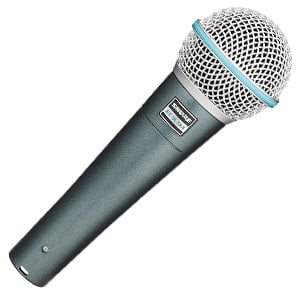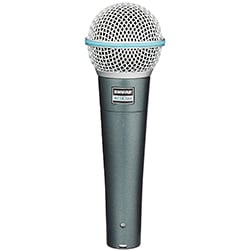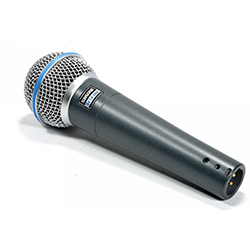- Home
- Instruments
- Gear
- Recording
- Lessons
- Reviews
- Blog


| Design: |  |
| Features: |  |
| Performance: |  |
| Value: |  |
Pull up any review of the Shure Beta 58A and you will undoubtedly also see the words ‘SM58’ nearby – a legendary Shure mic, considered one of the best dynamic microphones of all time. The reason is that these two mics share very similar qualities and are well worth comparing. However, the slightly more expensive Beta 58A is a solid vocal mic in its own right and, while it may never reach the status of its older brother, fully deserves its time in the spotlight for many reasons.

The design of the Beta 58A certainly represents an evolution of the legendary Shure SM58 – it’s familiar, but with a slightly fresher, more modern feel. This handheld mic features a sleek all-black, all-metal chassis topped with a very tough steel mesh grille.
This new grille design is far more resistant to physical damage and dents, as well as usual wear and tear. The grille features a blue strip where the two hemispheres meet, but that’s about it as distinctive aesthetics go. With a considerable weight and an all-round solid build, the Beta 58A feels robust and reliable enough for any stage, which puts it on par with the SM58 in that regard.

Things become most interesting when you pop the hood and take a look inside. The moment Shure announced the Beta 58A, many wondered what improvements this series would bring, while others questioned whether those upgrades would be worth the extra cost. Needless to say, Shure has hit a home run with this one.
The first major improvement is the supercardioid polar pattern, compared to the SM58’s standard cardioid. This offers more focus and, ultimately, less feedback when on stage. Then we have the advanced pneumatic suspension system housing the capsule, that does a great job of isolating the diaphragm from external factors, making it a quieter mic than the SM58. It also features a much stronger Neodymium magnet, which boosts sensitivity and does a lot to raise the output.
All of the new hardware has direct implications on the performance of the Beta 58A. Firstly, it packs a slightly extended frequency response range, which spans from 50Hz to 16kHz. That stronger magnet gives this mic more punch in the upper end of the range, but it also adds girth to the overall frequency response.
Using the Beta 58A on stage is a pleasure, as vocals cut through the mix much better thanks to its boosted output, coming across with good clarity and a bright midrange. The only thing you have to keep in mind – especially if you’re used to standard cardioid pattern mics – is that supercardioid pattern mics are more susceptible to sources of sound located right behind the microphone. However, this is easily solved with proper mic positioning on stage. Still, it’s worth being aware.
Shure’s Beta 58A still has some way to go to knock its older brother off the wall of microphone legends, but this is the best successor to the SM58 we could have asked for. The improvements are plain to see and translate to a noticeably smoother performance. The price difference may put some off, but it really feels worth the jump. Don’t be surprised to see many pros switching over to this newer model soon…
For more info about the Shure Beta 58A, click here.
For more Dynamic Microphone you might like, click here.

Reader Interactions